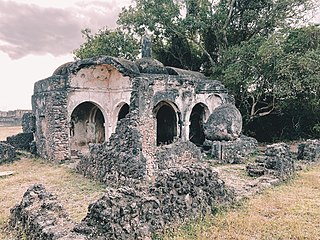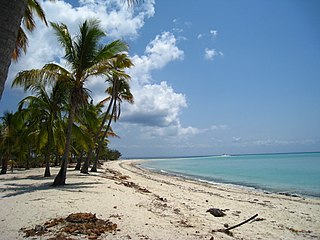
Mafia Island is an island and district of Pwani Region, Tanzania. The island is the third largest in Tanzanian ocean territory, but is not administratively included within the semi-autonomous region of Zanzibar, which has been politically separate since 1890. Mafia Island forms the major part of Mafia District, one of the six administrative districts in the Pwani coastal region. The local archipelago and the main island are sometimes called Chole shamba in Swahili, hinterlands of the former maintown of Chole on Mafia Bay.
Matuumbi, also known as Kimatuumbi and Kimatumbi, is a language spoken in Tanzania in the Kipatimu region of the Kilwa District, south of the Rufiji river. It is a Bantu language, P13 in Guthrie's classification. Kimatuumbi is closely related to the Ngindo, Rufiji and Ndengereko languages. It is spoken by about 70,000 people, according to the Ethnologue.

Rufiji is one of the six districts of the Pwani Region of Tanzania. It is bordered to the north by the Kisarawe and Mkuranga Districts, to the east by the Indian Ocean, to the south by the Kilwa District, Lindi Region and to the west by the Morogoro Region.

Kilwa District is one of six administrative districts of Lindi Region in Tanzania. The District covers an area of 15,000 km2 (5,800 sq mi). The district is comparable in size to the land area of the nation state of East Timor. Kilwa district is bordered to the north by Rufiji District in Pwani Region, to the east by the Indian Ocean, to the south by the Lindi District, Nachingwea District together with Ruangwa District, and to the west by the Liwale District. The district borders every other district in Lindi Region except Lindi Municipal District. The district seat (capital) is the town of Kilwa Masoko. The district is named after the medieval Swahili city state of Kilwa Kisiwani. According to the 2012 census, the district has a total population of 190,744.

Pwani Region is one of Tanzania's 31 administrative regions. The word "Pwani" in Swahili means the "coast". The regional capital is the town of Kibaha. The Region borders the Tanga Region to the north, Morogoro Region to the west, Lindi Region to the south, and surrounds Dar es Salaam Region to the east. The Indian Ocean also borders the region to its northeast and southeast. The region is home to Mafia Island, the Rufiji delta and Saadani National Park. The region is home to Bagamoyo town, a historical Swahili settlement, and the first colonial capital of German East Africa. According to the 2012 national census, the region had a population of 1,098,668, which was slightly lower than the pre-census projection of 1,110,917. From 2002 to 2012, the region's 2.2 percent average annual population growth rate was the seventeenth-highest in the country. It was also the 21st most densely populated region with 34 people per square kilometre., the region is slightly larger than Belgium.

Lindi Region is one of Tanzania's 31 administrative regions. The region covers an area of 66,040 km2 (25,500 sq mi). The region is comparable in size to the combined land area of the nation state of Sri Lanka. The regional capital is the municipality of Lindi. The Lindi Region borders on Pwani Region, Morogoro Region, Ruvuma Region, and Mtwara Region. The name Lindi is an old Swahili word meaning "hiding pits", a place where Swahili people will hide to defend themselves from hostile invasions. The region is home to two UNESCO World Heritage Sites, namely; Kilwa Kisiwani and Selous Game Reserve. According to the 2012 national census, the region had a population of 864,652, which was lower than the pre-census projection of 960,236. For 2002–2012, the region's 0.9 percent average annual population growth rate was the 29th highest in the country. It was also the least densely populated region with 13 people per square kilometer.

Handeni District is one of the 11 districts of Tanga Region in Tanzania. The District covers an area of 6,534 km2 (2,523 sq mi). It is bordered to the west by the Kilindi District and the Handeni Urban District, to the north by the Korogwe District, to the east by the Pangani District, and to the south by the Pwani Region. In 2002 Kilindi District was formed out of the district. The administrative capital of the district is Mkata town. According to the 2002 Tanzania National Census, the population of the Handeni District was 248,633. According to the 2012 census, the population had increased to: 276,646.

Liwale is one of the six districts of the Lindi Region of Tanzania. It is the largest district in Lindi and one of the largest in districts in Tanzania. It is bordered to the north by the Pwani Region, to the east by the Kilwa District, to the south by the Ruangwa District and to the west by the Morogoro Region. Most of Liwale district is within the Nyerere National Park.

Lindi District also known as Mtama District is one of six administrative districts of Lindi Region in Tanzania. The District covers an area of 5,975 km2 (2,307 sq mi). Kilwa district is bordered to the north by Kilwa District, to the east by the Indian Ocean and Lindi Municipal District, to the south by the Mtwara Region, and to the west by the Nachingwea District. The district seat (capital) is the town and ward of Mtama. The district is known for the Tendaguru Formation, the richest Late Jurassic strata of fossils in Africa. According to the 2012 census, the district has a total population of 191,143.

Kilwa Masoko or Masoko is an administrative ward in Kilwa District of Lindi Region in Tanzania. The ward covers an area of 200 km2 (77 sq mi), and has an average elevation of 11 m (36 ft). The ward is also the capital of Kilwa District. According to the 2012 census, the ward has a total population of 13,601.
The Ngindo are an ethnic and linguistic group based in southern Pwani Region, eastern Ruvuma Region, southern Morogoro Region and northern Lindi Region means in current area includes Liwale and Kilwa districts in current Tanzania or former Tanganyika, who speak the Ngindo and Ndendeule languages. In 1987 the Ngindo population was estimated to number 220,000 Prominent Ngindo people include. Saidi Alli Amanzi former District Commissioner of Masasi, Nyamagana, Morogoro and Singida from 2006 to 2016, Poet Amir Abdallah Sudi 'Andanenga' whose nickname Andanenga derives from two Ngindo words where anda means like and nenga means right me or me, therefore better translated as like me and some others. .
The Matumbi are a Bantu ethnolinguistic group native to Kilwa District, Lindi Region in southern Tanzania, who speak the Matumbi language. They are also the native inhabitants of the Songosongo island archipelago. Their homeland is also south of the Rufiji delta in southern Pwani Region in Rufiji District. In 1978 the Matumbi population was estimated to number 72,000. They are the largest ethnic group in Kilwa District. The Matumbi Highlands are named after them.

The Zanzibar Archipelago consists of several islands lying off the coast of East Africa south of the Somali sea. The archipelago is also known as the Spice Islands. There are four main islands, three primary islands with human populations, a fourth coral island that serves as an essential breeding ground for seabirds, plus a number of smaller islets that surround them and an isolated tiny islet.
Kinjikitile "Bokero" Ngwale was a Tanzanian spiritual medium and a leader of the 1905–1907 Maji Maji Rebellion against colonial rule in German East Africa.

Songo Songo Island is the main island of the archipelago of the Songosongo Islands located in Songosongo ward of Kilwa District of Lindi Region in Tanzania. It is served by the Songo Songo Airstrip. The island's native inhabitants are the Matumbi people.

National Historic Sites of Tanzania is an official list of places in Tanzania that have been designated as National Historic Sites as per the Ministry of Natural Resources and Tourism of Tanzania under the Antiquities Division. The list is not complete and is currently being updated.
Songosongo is an administrative ward in Kilwa District of Lindi Region in Tanzania. The ward covers an area of 8.5 km2 (3.3 sq mi), and has an average elevation of 11 m (36 ft). According to the 2012 census, the ward has a total population of 3,056. The ward administers the whole archipelago of the Songosongo Islands, which are composed of 22 coral reefs and 4 coral islands; Songo Songo Island, Fanjove Island, Nyuni Island and Okuza Island. The islands ward's native inhabitants are the Matumbi people. The archipelago is composed of 21 coral reefs including the 4 islands. The ward seat is Songosongo village. In addition there are four hamlets on the islands; Pembeni, Makondeni, Msitumani and Funguni.
Mingumbi is an administrative ward in Kilwa District of Lindi Region in Tanzania. The ward covers an area of 258.5 km2 (99.8 sq mi), and has an average elevation of 114 m (374 ft). According to the 2012 census, the ward has a total population of 9,948. The ward seat is Mingumbi village.
Nan'goma Cave is a cave system located in Kipatimu and Kibata ward of Kilwa District in Lindi Region of Tanzania.
Mbwemkuru River is located in the southern part of Lindi Region, Tanzania. It begins in Lilombe ward in Liwale District and drains on the border of Kilolambwani and Lihimalyao wards on the Indian Ocean, with the former in Lindi District and the Latter in Kilwa District. The river is the largest and longest river in Lindi region.










